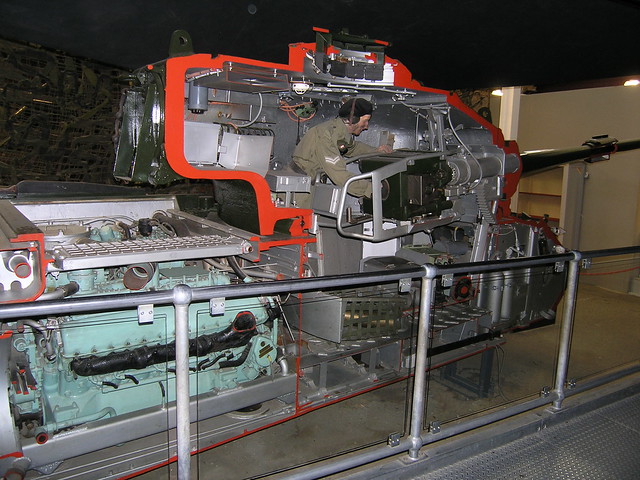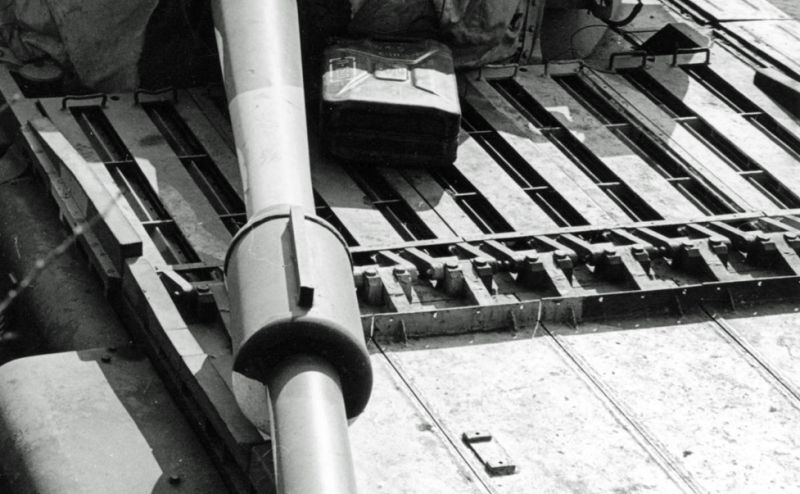
 |
|
#31
|
||||
|
||||
|
Quote:
I'm sure that you knew exactly what you meant when you wrote 'they hinge at the front.' Unfortunately my knowledge of the vehicle is not as great and I have to admit that I'm not really sure what you meant by your description. Below is a photograph of the rear deck of a standard Centurion. Using this as a frame of reference, was the oil cooler under one of those things on the rear deck between the turret and the engine cover? Are they some kind of access hatches? Did the hatches rotate forward or just come straight off? Did the oil cooler lift straight out, or rotate up on a hinge? Any information that you can provide would be greatly appreciated. Cheers, Dan  |
|
#32
|
||||
|
||||
|
Matt,
I think I've answered my own question. Below is a photograph of the cutaway Centurion tank at the museum in Bovington. From this angle the oil cooler, painted silver, with its front hinge can be clearly seen, as can the engine. Still curious about the what everything is on the rear deck of the vehicle. Cheers, Dan.  |
|
#33
|
|||
|
|||
|
Dan,
The rear deck of a Cent consists of two sets of hinged covers: the forward set of five interlocking covers are the engine compartment covers, the rear set are the transmission covers. Both sets must be lifted in the correct sequence (different for each set). The engine compartment covers hinge at the rear, and are lifted from the front, ie closest to the turret, hinging backwards over the transmission covers. The turret must be positioned in the correct part of the traverse for each engine cover in turn to be lifted. (The transmission covers hinge forwards, and are rested against the side of the turret when open). The oil cooler is below the engine covers, slightly right of the Meteor engine centerline. It is hinged at the front, ie nearest the turret, to allow it to be rotated clear for access to other parts of the engine peripherals, but does not require disconnection from the oil lines (which connect at each side of the pivot point or 'hinge'). It pivots in an arc upwards, and as the image shows, can be lent against the turret between the bins if the turret is in the correct position. Mike C |
|
#34
|
||||
|
||||
|
Mike,
This time I think I'm finally starting to get a hang of everything you've been trying to tell me. I took the earlier photograph of the tanks on the train and cropped it down to just the rear deck of the last vehicle. I can see the five engine (forward) and five transmission (rear) covers quite clearly. All rotating on the same single hinge. Just so that I'm clear in my mind, the engine covers and the transmission covers can't be opened for maintenance at the same time, and for each individual engine cover to be opened the turret must be made to rotate a few degrees. If I'm right, what a pain in the butt this vehicle must have been. Cheers, Dan  |
|
#35
|
|||
|
|||
|
Hi Dan and Mike
To lift both sets,The radiator covers are opened first then the radiators are opened, the louvers then rest back on the radaitors, the engine covers are then lifted and lay against the rear set thus giving access to both sides. Kind Regards Forgot to mention that with the turret rotated to the left, you remove both turret bins and all the louvers can be opened at once(in order of cause). |
|
#36
|
|||
|
|||
|
Yes, however, removing the two turret bins was a tedious process, as they mounted on studs with nuts and washers. I think the Canadians et al all left theirs in that original configuration, and continued to lift the covers in sequence by rotating the turret, as per the manual.
Whereas Australia devised a modification that mounted the bins on steel straps attached to the back of each bin, and held to the turret by u shaped pieces - the straps slid into the u shaped pieces that were welded to the turret in place of the studs. The bins could be lifted clear of the turret quickly by a couple of the crew - I think your Cent has that mod, Matt? Makes bin removal and cover-lifting a whole lot simpler. Mike C |
|
#37
|
|||
|
|||
|
That would explain the extra bits inside some of my NOS turret bins. Painted in primer only, they must be part of the Aussy modified fitting kit.
Although, on reflection, my bins are the long ones, but I guess a modification to the mounting of the short bins would have been carried over to the long one? Rich.
__________________
C60S Austin Champ x 2 Humber 1 Ton & Trailer |
|
#38
|
|||
|
|||
|
Richard,
No: only the left hand (two short bins) were so modified. The long bin had a mod to mount the Unigun: maybe they are to do with that? Mike C |
|
#39
|
||||
|
||||
|
Resurrecting this old thread with a question. Did Canada ever use the long range hull with the bolt on 100 gallon tank like the Australians did?
Regards John |
 |
| Thread Tools | |
| Display Modes | |
|
|